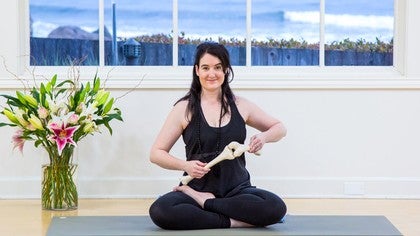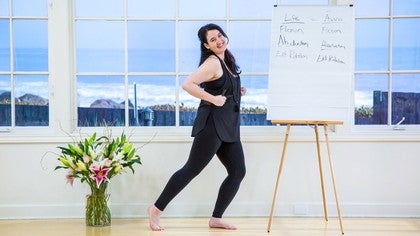Description
Transcript
Read Full Transcript
A lot of our asana will ask our hips to do external rotation and our knees to do flexion at the same time. So this pose that I'm in, I have that situation going on in my joints, or the fancier interpretations of half lotus artipadmasana or full lotus padmasana, ankle to knee, pigeon pose, the fancy leg and tree, all of these poses are asking for this very familiar external rotation at the hips and flexion in the knee. Now this is on the body's resume, so it will do it, but unfortunately when we're asking to deepen these postures or exaggerate the postures, the deeply set congruent hip is not going to budge. What's going to budge first is this knee, and unfortunately we start to ask unwittingly of the knee to do this rotation that it's not fond of and can cause those loosey-goosey ligaments or rubbing of the meniscus in an inappropriate way, causing all sorts of death and destruction to the knee. Let's take a look. So we have here our model of a femur and our model of a tibia, and the articulation really just wants to be this flexion extension. It's almost like a little rocking horse. It rocks slightly forward on the movement of flexion or bending the knees, and it rocks slightly backwards on the movement of extension. It really does not want to rotate. It's not meant for it. So as I'm sitting here, you can feel your own tibial tuberosity, the potato of your shin. It really is lining up well and not twisting, just inflection.
But as soon as I try to take my leg a little bit deeper, now I have a lot of external rotation in my hips. It's something that perhaps is in the genetic cards for me, and years of gymnastics and dance and yoga might have encouraged a little bit more. But I can bring my first leg into Ardha Padmasana without having to twist my knee. The relationship between the femur and the tibia is still pretty sweet. To get my second leg, though, into Lotus, I have to do this really wild kind of up and over action. I have to leverage a little bit of rotation to get my second leg into Padmasana. Now, if you look at the tibial tuberosity, it's now kind of looking up at the ceiling rather than staying in that sweet alignment. So it's a little bit twisting. My thigh is rotating in one direction. My shin is rotating in the other direction, causing rotation at the knee. Now, I can do this easily. There's no pain. I look like the cover of yoga journal. I look like a proper yogi. But it's maybe not worth it for my knee. And I've made the call because of how I answered that journal exercise, why I do Asana. I really want to have longevity in my knees. My friend Sarah Finger says, the knees are like your grandma's tea cups, porcelain tea cups. You only have one set. They're precious and they're delicate. So for me, it's not worth taking that second leg up. This also shows up quite a lot in Pidgin. Pidgin pose is a really famous pose that we do in a lot of yoga classes. So let's kind of take a look at what happens in Pidgin. So as I bring my leg forward, now I have, don't be jealous, I have a lot of external rotation available in my own hips. So I can come into Pidgin without too much fanfare. I'm externally rotating my front hip and I'm flexing in my knee. And there's still a pretty sweet relationship between my femur and my tibia. Now what happens when your teacher sees someone that has a good fair amount of external rotation available is sometimes they give that cue to make it deeper, walk your front foot forward, chin parallel to the front of the mat. Now, if you look at that action, when I walk my foot forward, all of a sudden now my tibia and my femur are going wild. Bones gone wild. And they're twisting. So sometimes I say, well, to protect the knee, flex through the foot. Well, if you notice when I flex through my foot, my tibia went even more wild, rotating even more. So sometimes I think as teachers, we just say what our teacher said, and maybe at some point that was right for someone, but it's not right for most. So if you have a fair amount of external rotation like me, I would say walk your foot closer into your pelvis, point your toes, crazy, wrap the tibia down. So the tibial tuberosity, if it was like a little eyeball, it'd be peeking down. And then with the weight of your body, with gravity pulling down, even your body weight, if you were to go deeper in, is not going to force a twisting in the knee or any kind of hammocking into that joint. We also see padding options given for pigeon pose. So a lot of times teachers will say, we'll pad up under this front tush cheek. I think that that maybe is not the sweetest for most. Another option that you can give is taking the padding all the way under the femur. So from tush to knee, if your seat is not coming to the floor, a little safer for most people, resisting the urge to let the knee rotate to help you out here. Another adaptation of this pigeon pose is to do it on your back. I like this pose and I teach it most often. When you come down onto your back, you have a different relationship to gravity. When you cross your ankle over your knee, you only have kind of your will and your hand strength, your arm strength to bring the leg in. In this case, I like taking the leg across so your foot doesn't sickle. See if I point my foot and I bring my leg in, you're twisting the knee. So taking the ankle a little bit off, flexing the foot here in this situation, drawing big toe, pinky toe back, engaging the muscles in the shin, keeping that femur and tibia in sweeter relationship.
And then you can see it and you have control of how much you'd like to bring the thigh in towards the chest. So I hope that helps bring you into a sweeter relationship of the femur and tibia and keep you away from some of the drama that happens in a yoga practice.
Your Body on Yoga: Lower Appendage
Comments
You need to be a subscriber to post a comment.
Please Log In or Create an Account to start your free trial.












